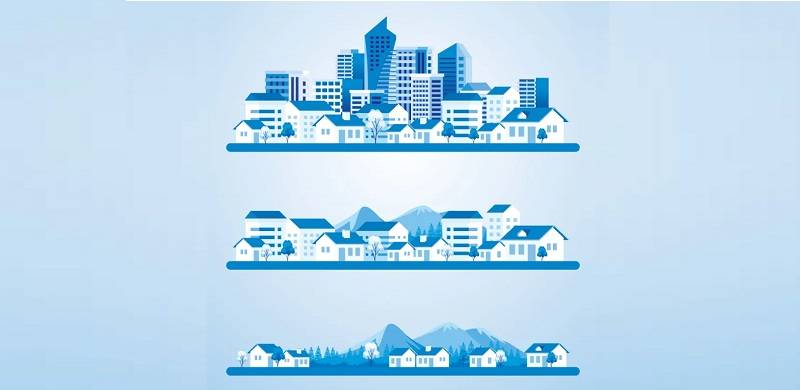
Intermediate cities of Pakistan will account for a massive chunk of the urban population in the future. Young populations drive their expansion with high birth rates and substantial rural-to-urban migration. Intermediate cities can provide a crucial link between isolated agricultural areas, connected networks of people and economic activities (including agricultural supply chains and small entrepreneurial systems). However, the undervalued role of low-income intermediate cities leaves us with limited evidence of their socioeconomic dynamics and potential and fewer partnerships to help deliver change. This creates development gaps, as there currently needs to be more development in these intermediate cities. So, Pakistan needs to reduce the gap between mega and intermediate cities, explore the latter's potential for economic growth, create jobs, support manufacturing and industries, and link agricultural areas with markets. Unfortunately, focusing on intermediate cities is not a priority in a country where mega cities combine sprawls and congested old towns. However, today's successful economies have a small socioeconomic gap between mega and intermediate cities.
As already discussed, intermediate cities that are home to many small businesses turn out to be more entrepreneurial and attract more young entrepreneurs. The reason is that in megacities, new entrepreneurs and start-ups are less likely to be recognised and appreciated than in intermediate cities. New entrepreneurs would gain lower incentives than they would if they were operating in a small country because of fewer business ventures. Life is easier for entrepreneurs in intermediate cities, and they can attract many customers. Building up a solid customer base is one of the critical ingredients for a successful business. Therefore, start-up ventures can quickly build their customer base in an intermediate city before moving on to a large city. In addition, intermediate cities have low land rent and many housing options. For an entrepreneur, an intermediate city can help cut down the cost of living and give various options to build up the business than a mega city may offer.
The government of Pakistan can take many steps to devise urban policy for intermediate cities to encourage entrepreneurial growth and development in intermediate cities. First, there must be new and friendly investment initiatives in the context of private sector consultation, especially in intermediate cities with fewer entrepreneurs. To recognise, promote and support the high growth potential of small and medium businesses, the government of Pakistan should launch an equity investment fund. Second, the government could reduce the markup on current funding for small businesses operating in intermediate cities and eliminate the burden of the excess markup from the facility.
Several arguments have been developed regarding renewed investment in intermediate cities and policy attention to the growing number of such urban zones. Firstly, many intermediate cities offer optimal economic growth conditions, combining adequate amounts of agglomeration and density with a more humane dimension. Secondly, they provide considerable potential for addressing urban deprivation and poverty: as essential destinations for rural and small-town migrants, as sites of non-farm employment, and as catalysts for economic activity and modernisation. Thirdly, intermediate cities can leverage the many quality-of-life and business environment advantages to tap into new, dynamic industries. As such, intermediate cities can play a catalysing role in poverty reduction and the structural transformation of regional economies towards modern industries. Therefore, urban policy must catch up with the new wave of evidence and recognise the potential of intermediate cities as drivers of economic development. Crucially, this involves ensuring that urban policies are open to megacities and large urban agglomerations, but also acknowledging that the challenges affecting intermediate cities are not necessarily homogeneous. This will guarantee that the economic potential of intermediate cities and regions remains relevant and that the economic benefits linked to urbanisation reach wider layers of the population.
In sum, huge opportunities in the small cities needed to be fast-tracked. Moreover, considering the ongoing economic crisis and the high level of unemployment, it is even more important to focus on intermediate cities.
As already discussed, intermediate cities that are home to many small businesses turn out to be more entrepreneurial and attract more young entrepreneurs. The reason is that in megacities, new entrepreneurs and start-ups are less likely to be recognised and appreciated than in intermediate cities. New entrepreneurs would gain lower incentives than they would if they were operating in a small country because of fewer business ventures. Life is easier for entrepreneurs in intermediate cities, and they can attract many customers. Building up a solid customer base is one of the critical ingredients for a successful business. Therefore, start-up ventures can quickly build their customer base in an intermediate city before moving on to a large city. In addition, intermediate cities have low land rent and many housing options. For an entrepreneur, an intermediate city can help cut down the cost of living and give various options to build up the business than a mega city may offer.
The government of Pakistan can take many steps to devise urban policy for intermediate cities to encourage entrepreneurial growth and development in intermediate cities. First, there must be new and friendly investment initiatives in the context of private sector consultation, especially in intermediate cities with fewer entrepreneurs. To recognise, promote and support the high growth potential of small and medium businesses, the government of Pakistan should launch an equity investment fund. Second, the government could reduce the markup on current funding for small businesses operating in intermediate cities and eliminate the burden of the excess markup from the facility.
Several arguments have been developed regarding renewed investment in intermediate cities and policy attention to the growing number of such urban zones. Firstly, many intermediate cities offer optimal economic growth conditions, combining adequate amounts of agglomeration and density with a more humane dimension. Secondly, they provide considerable potential for addressing urban deprivation and poverty: as essential destinations for rural and small-town migrants, as sites of non-farm employment, and as catalysts for economic activity and modernisation. Thirdly, intermediate cities can leverage the many quality-of-life and business environment advantages to tap into new, dynamic industries. As such, intermediate cities can play a catalysing role in poverty reduction and the structural transformation of regional economies towards modern industries. Therefore, urban policy must catch up with the new wave of evidence and recognise the potential of intermediate cities as drivers of economic development. Crucially, this involves ensuring that urban policies are open to megacities and large urban agglomerations, but also acknowledging that the challenges affecting intermediate cities are not necessarily homogeneous. This will guarantee that the economic potential of intermediate cities and regions remains relevant and that the economic benefits linked to urbanisation reach wider layers of the population.
In sum, huge opportunities in the small cities needed to be fast-tracked. Moreover, considering the ongoing economic crisis and the high level of unemployment, it is even more important to focus on intermediate cities.

